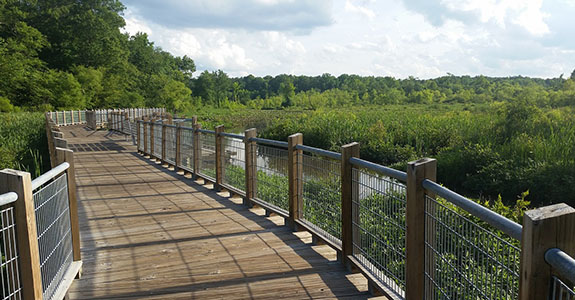
 Department of Conservation and Recreation
Department of Conservation and Recreation
Conserve. Protect. Enjoy.
 Department of Conservation and Recreation
Department of Conservation and Recreation

From the Center for Disease Control.
Studies indicate that trails have large, long-term economic benefits in both rural and urban areas. In addition to their intrinsic value, trails increase property values, factor in corporate relocation decisions, provide business opportunities for commercial activities, generate expenditures on lodging, food, trail management and recreation-oriented services. Trails can also decrease public costs by reducing the impacts of floods, congestion, and physical inactivity.
More information on measuring the economic and social impacts is available at these links:
You can read more about the economic impacts of trails in Virginia at the following sites:
The development of a connected and marked system of trails is in the national interest for these reasons:
Should the supply of fuel be reduced or priced out of range, most people will still be able to make most of their trips (56 percent of trips are less than 5 miles and 75 percent are under 10 miles).
In the event of a natural disaster, the trail system will provide an evacuation route if highways are clogged or damaged or provide alternate access routes for emergency crews.
The transportation sector accounts for the largest share of greenhouse gas emissions. People who bicycle every day have 84 percent lower carbon dioxide emissions from all daily travel than non-cyclists. Read more
The use of flood-prone areas for greenways prevents potential flood damages and related costs if these areas were developed. The protection of open space along waterways for greenway development also protects water quality.
Three-quarters of Americans are not regularly active, and inactivity rates are increasing. In addition to reducing our readiness to face disasters, this national fitness crisis costs the nation billions of dollars in annual medical costs. Indirect costs accrue from loss of wages and productivity. Costs associated with physical inactivity account for more than 11% of total health care expenditures and are estimated at $117 billion annually. Lack of exercise is a major cause of chronic diseases. Read more
Studies performed by the Centers for Disease Control and Prevention found that increased access to places to be active can boost the number of people getting enough exercise at least three days a week by 25 percent. The U.S. spends approximately 40 percent more than other countries on health care, while only 2 percent of this annual health care cost is allocated for disease prevention. Read more.
Virginia, along with other Southern states, is in the Stroke Belt, where stroke death rates are substantially higher than in the rest of the country. Physical activity reduces the risk of stroke.
A quarter of Virginians are obese, and 62 percent are obese or overweight. Obesity is a risk factor for chronic disease. The prevalence of overweight children and adolescents has increased dramatically, along with the incidence of type two diabetes in these age groups.
A third of the population, including children and a growing number of elderly, depend on public service or a friend or relative for their mobility. Independent mobility, critical for many adults, is also an important part of healthy child development. As the price of gasoline increases, the margin of people who don't drive will also increase. While it is estimated that 10 percent of all U.S. trips occur on bike or foot, only about 1.5 percent of federal transportation dollars fund bike paths and walking trails.
The burden of obesity, asthma and pedestrian/bicycle fatalities are borne disproportionately by minority populations. Read more about Active Living and Social Equity.
Trails close to home are a wonderful recreation resource for families because they support independent mobility and families can exercise together at their convenience without expensive gear. Trails also provide children with a critical link to nature, connecting them to natural landscapes, and allowing them access to unstructured play in the outdoors.
Children are increasingly playing indoors under adult supervision, often using electronic media. They have less free time and spend more time in structured activities, and know very little about their environment. Parents, who identify safety as the biggest barrier to children's independent play, may not be aware of the importance of unstructured play in promoting healthy child development.
The Children and Nature Network, co-founded by Richard Louv http://richardlouv.com/, is building a movement to reconnect children with nature. Nature plays a special role in developing a child's imagination and sense of place, and the increasing children/nature divide has environmental, social, psychological, and spiritual implications.
The number of children who live within a mile of school and usually walk or bike there has declined almost 25 percent over the past 30 years. Safety is a big concern for parents, who may not realize that the decline in walking and bicycling has had an adverse effect on traffic congestion and air quality around schools. Read more at National Center for Safe Routes to School and the Federal Highway Administration.
A connected system of trails and greenways can enhance biodiversity by providing migratory routes for wildlife and enhance the ecological function of riparian areas by restoring aquatic/wetland habitat. By exposing trail users to special places, trails build public support for the protection of natural beauty, historic significance, distinctive geography, and ecological diversity.

